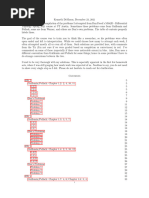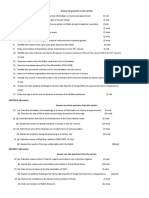class 8 Sound
class 8 Sound
Uploaded by
subojit Kumar KarCopyright:
Available Formats
class 8 Sound
class 8 Sound
Uploaded by
subojit Kumar KarCopyright
Available Formats
Share this document
Did you find this document useful?
Is this content inappropriate?
Copyright:
Available Formats
class 8 Sound
class 8 Sound
Uploaded by
subojit Kumar KarCopyright:
Available Formats
Delhi Public School,Raipur
CLASS 08 - SCIENCE
SOUND
1 Sound can propagate through ________.
a) only gases and solids
b) vacuum as well as gases
c) only gases and liquids
d) any of the three states of matter
2 When sound passes from air to water, its wavelength
a) Increases
b) Decreases
c) Neither Increase nor Decrease
d) Remains constant
3 Sound frequencies which cannot be detected by human ear are called as
a) Both Infrasound frequency and Ultrasound frequency
b) Infrasound frequency
c) Audible frequency
d) Ultrasound frequency
4 Bat can know about their prey at a long distance even in the night by emitting
a) chemicals from their body
b) ultraviolet lights
c) ultrasonic sounds
d) infra - red lights
5 Define frequency, amplitude and time period of a vibration.
Ans: The number of oscillations made by an object in one second is known as frequency.
The SI unit of frequency is Hertz.The maximum displacement of the object from its mean
position is known as amplitude. The SI unit of amplitude is meter.The time taken to
complete one oscillation by an object is called time period. The SI unit of time is second.
6 1. What is one vibration in a second called as?
2. What is oscillation? A vibrating object produces 156 waves in four second.
Calculate the frequency of the vibrating object.
Ans: a. One vibration in a second is called as Hertz.
b. To and fro motion of a vibrating object is called oscillation.
Frequency =156 /4 = 39Hz
7 The town hall building is situated close to Boojho’s house. There is a clock on the top of
the town hall building which rings the bell every hour. Boojho has noticed that the sound
of the clock appears to be much clearer at night. Explain.
Ans: We know that speed, pitch, loudness all are initiated with a vibration. During the
day, there is a number of vibrations around us.So, the sound coming from the clock gets
disturbed and the amplitude of vibrations becomes small. But during the night, there
arenot such multiple vibrations in the environment. So, the sound is more clear. Further,
"the dew factor at night increases the speedof sound as moisture level increases."
8 What is frequency range for human ear? What is audible and inaudible sounds?
Ans: The range of human ear is between 20Hz to 20000Hz.The sound frequency between
this range is called audible sound.The sounds having frequency less than 20 Hz is known
as inaudible sounds.
9 What causes deafness?
Ans : A part of the energy that is used to produce sound gets converted into a sound wave.
Sound is, therefore, a source of energy. Avery loud sound has greater amount of energy
and would, therefore, vibrate the eardrum with tremendous force and can even tear it.
Such damage to the ear would lead to deafness.
10 Show experimentally that sound waves can travel through liquids.
Ans: To show that sound travel through liquids, take a bucket full of water and a bell.
Now hold the bell gently and dip it into the waterbucket, making sure that your hand or
bell does not touch the sides of the bucket. Bend your head into the bucket so that your
eartouches the surface of water. Gently shake the bell inside the water, you will be able to
hear the sound of bell clearly. Thus it is clear that sound waves can travel through liquids
11 How does human produce sound?
Ans: Humans communicate with each other by speaking. In humans, the sound producing
organ is called larynx or voice box which ispresent at the upper end of the wind pipe in
the throat region. Inside the larynx or voice box there are two vocal cords made up
ofligaments, which are stretched across it just like a string. When lungs force out air
through larynx, the vocal cords vibrate toproduce sound. So whenever we speak or sing,
our vocal cords vibrate due to the air expelled from the lungs, producing sound.
12 Write the applications of the ultrasound.
Ans: (i) Ultrasound is used as diagnostic tool in medical science.(ii) It is used to relieve
pains in joints and muscles.(iii) It is used to detect flaws in metals and structures.(iv) It is
used to test the thickness of various parts.(v) In the process of electrocardiography, the
ultrasonic waves are used to form an image of the heart using reflection anddetection of
these waves from various parts.(vi) Medical ultrasound is a diagnostic imaging technique
based on ultrasound.(vii) Ultrasonic waves are used to break stones in the kidney.
13 Explain how the human ear works?
Ans: Humans are able to hear with the help of ears. Human ear is sensitive to sound.
Human ear consists of three parts i.e. Outer ear,Middle ear and inner ear. The part of ear
which we can see is the outer ear which collects sound waves that are conducted
throughauditory canal. These waves fall on the ear drum and then sent into vibrations.
The vibrations of the incoming sound are sent tothe next part of the ear. Middle ear
enlarges these oscillations. Inner ear converts these pressure waves into electrical signals
andsend them to auditory nerves. These nerves transfer the signals to the brain and the
brain interprets the sound.
14 What is the difference between percussion and string instrument?
Ans: In string instruments like guitar, violin, sitar etc., metal strings of specific metal
and thickness are made to vibrate to producesounds. Sounds of different musical notes
can be produced by controlling thickness and tightness of strings in these
instrument.Percussion instruments are generally used to provide beats to the music e.g.
bass drum, dholak, tabla etc. In all theseinstruments, a specific hollow shape is closed.
The vibrated stretched skin produces loud sound by a stretched skin of an animal.The
stretched skin is beaten with a stick or by hand to make it vibrate.
15 What would happen if there were no voice boxes in our throat?
Ans: If there were no voice box in our throat, we would not be able to speak or talk
because there is nothing to vibrate through whichsound can be produced. In voice box
there are two vocal cords. When lungs force out air through voice box, the vocal cords
vibrate to produce sound.
16 Sound needs a material medium to propagate. Explain?
Ans: Sound is produced due to vibration. The vibration makes the air around vibrate and
the air vibrations enter the ear. When an objectvibrates, it disturbs the air around it. The
molecules of air in contact with vibrating objects also start to vibrate. The vibrating
airmolecules in turn, make more air, it makes a long chain of sound waves. Sound waves
travel in all direction through a materialmedium like air, water or solids, called
propagation of sound. Sound cannot travel in absence of medium because in empty
spacethere is no molecules which help the sound to travel.
17 Assertion (A): Sounds produced by horns ofbuses and trucks are considered to be
pleasant sounds.
Reason (R): Sounds which are pleasing to ear are called musical sound.
a) Both A and R are true and R is the correct explanation of A.
b) Both A and R are true but R is not the correct explanation of A.
c) A is true but R is false.
d) A is false but R is true.
18 Assertion (A): Vibration in a object makes it to produce sound.
Reason (R): Vibration cause movement in air molecules.
a) Both A and R are true and R is the correct explanation of A.
b) Both A and R are true but R is not the correct explanation of A.
c) A is true but R is false.
d) A is false but R is true.
19 Assertion (A): Frequency of vibration is expressed in terms of hertz.
Reason(R): The number of oscillations per second is called frequency of oscillation.
a) Both A and R are true and R is the correct explanation of A.
b) Both A and R are true but R is not the correct explanation of A.
c) A is true but R is false.
d) A is false but R is true.
20 Assertion (A): Amplitude of sound decides it’s loudness.
Reason (R): Loudness of sound is proportional to square of amplitude.
a) Both A and R are true and R is the correct explanation of A.
b) Both A and R are true but R is not the correct explanation of A.
c) A is true but R is false.
d) A is false but R is true.
21 Assertion (A): A drum has low pitched sound than a whistle.
Reason (R): pitch of sound depends upon loudness.
a) Both A and R are true and R is the correct explanation of A.
b) Both A and R are true but R is not the correct explanation of A.
c) A is true but R is false.
d) A is false but R is true.
You might also like
- Ciccarelli PrefaceDocument23 pagesCiccarelli PrefaceSarath V Winterina Mariposan50% (2)
- 1693037026467Document8 pages1693037026467GunikaNo ratings yet
- Sound Chapter Notes Grade 8 Ksdgflks GDocument8 pagesSound Chapter Notes Grade 8 Ksdgflks GdarshanraunathanNo ratings yet
- (SOUND) ch13Document11 pages(SOUND) ch13heena7901700368No ratings yet
- Ch-13 Sound(class 8)Document8 pagesCh-13 Sound(class 8)vaanyas120No ratings yet
- Physic Sound Cls7Document14 pagesPhysic Sound Cls7itsbeserkfuelNo ratings yet
- NCERT Solutions For Class 8 Science Chapter 13Document5 pagesNCERT Solutions For Class 8 Science Chapter 13kaushidpendorNo ratings yet
- SoundDocument5 pagesSoundAafan ShahidNo ratings yet
- Ch-13. SOUNDDocument6 pagesCh-13. SOUNDNiha KausarNo ratings yet
- REVISION_2_SOUNDDocument3 pagesREVISION_2_SOUNDyadvbaby1985No ratings yet
- NCERT Solutions for Class 8 Science Chapter 10 Sound - Free PDF DownloadDocument5 pagesNCERT Solutions for Class 8 Science Chapter 10 Sound - Free PDF Downloadvishnuvardhan4615No ratings yet
- 3 P YDuf 8 D Sdo A5 SC 4 F PezDocument8 pages3 P YDuf 8 D Sdo A5 SC 4 F Pezash839840No ratings yet
- NCERT Solutions For Class 8 Science Question Chapter 13 ExerciseDocument5 pagesNCERT Solutions For Class 8 Science Question Chapter 13 ExerciseloluNo ratings yet
- chapter_13_sound_class_08_book_science_mission_question_answerDocument3 pageschapter_13_sound_class_08_book_science_mission_question_answerSweety GuptaNo ratings yet
- Important Questions For CBSE Class 8 Science Chapter 10 - SoundDocument8 pagesImportant Questions For CBSE Class 8 Science Chapter 10 - SoundsateeshhanotiyaNo ratings yet
- APznzaawQpvP1WSKnDfQxoPnLNvPPh8gzBo6etL9_hHTGmbq5XbhysZx9oDwWmi3PkEuHQ5vuHWeV5Z3VJiHx1EECKwUp8tmTbZ3SWD94pe5axP-cp4W_GEBfCyDPgw2lu0XYN6l4v7w-IpLTkeHiu1soptYcX-AGwX-L7WVUIYrqdorRsGMsn-ieMtXc-Ao5OepH-n1rzhhkPb7DWCNz2Document6 pagesAPznzaawQpvP1WSKnDfQxoPnLNvPPh8gzBo6etL9_hHTGmbq5XbhysZx9oDwWmi3PkEuHQ5vuHWeV5Z3VJiHx1EECKwUp8tmTbZ3SWD94pe5axP-cp4W_GEBfCyDPgw2lu0XYN6l4v7w-IpLTkeHiu1soptYcX-AGwX-L7WVUIYrqdorRsGMsn-ieMtXc-Ao5OepH-n1rzhhkPb7DWCNz2kalash iyerNo ratings yet
- Sound Imp QuedDocument27 pagesSound Imp Quedlavanyaadhikari5bivpsNo ratings yet
- Chapter 12 SoundDocument8 pagesChapter 12 SoundtusitwinkleNo ratings yet
- Chapter 11 Sound Short QuestionsDocument3 pagesChapter 11 Sound Short QuestionsKashif FazalNo ratings yet
- Class 9th SoundDocument10 pagesClass 9th Soundakash vermaNo ratings yet
- Revision Assignment SoundDocument17 pagesRevision Assignment Soundrajesh duaNo ratings yet
- CH13 Sound AssignmentDocument3 pagesCH13 Sound Assignmentanshika1792010No ratings yet
- RBSE Class 8 Science Notes Chapter 10 Sound - RBSE GuideDocument3 pagesRBSE Class 8 Science Notes Chapter 10 Sound - RBSE GuideAlpine AcademiaNo ratings yet
- Sound: Multiple Choice QuestionsDocument5 pagesSound: Multiple Choice QuestionsAkash SahaNo ratings yet
- Untitled Document 7Document6 pagesUntitled Document 7Khan SahilNo ratings yet
- Chapter - 6 (Physics) Sound Std-7 Answer The Following QuestionsDocument6 pagesChapter - 6 (Physics) Sound Std-7 Answer The Following QuestionsDinasalimNo ratings yet
- 2.NCERT Exemplar Class 8 Science Solutions Chapter 13 SoundDocument10 pages2.NCERT Exemplar Class 8 Science Solutions Chapter 13 Soundmishraishita0510No ratings yet
- CH 13Document9 pagesCH 13Mayankkumar MistryNo ratings yet
- Ch 12 soundDocument11 pagesCh 12 soundriseandthrive309No ratings yet
- Ncert NotesDocument8 pagesNcert NotesnebulamoghNo ratings yet
- 09 Science Notes Ch12 SoundDocument10 pages09 Science Notes Ch12 SoundHarshJangidNo ratings yet
- Sound Lesson 3Document27 pagesSound Lesson 3rajesh duaNo ratings yet
- Ound NotesDocument5 pagesOund Notesmokshithakapoor657No ratings yet
- Sound EnergyDocument7 pagesSound EnergysaibapritulNo ratings yet
- SoundDocument23 pagesSoundROSALIE CLARITONo ratings yet
- 16. SoundDocument8 pages16. Soundnutifafa hossah aborgahNo ratings yet
- Class Note1Document3 pagesClass Note1Rajan DubeyNo ratings yet
- Sounds All AroundDocument21 pagesSounds All AroundAreeb SiddiquiNo ratings yet
- complete notes of chapter- SoundDocument16 pagescomplete notes of chapter- SoundGurdeep SinghNo ratings yet
- CH # 11Document11 pagesCH # 11Farhat AbbasNo ratings yet
- Notes soundDocument6 pagesNotes soundashwin rajputNo ratings yet
- Notes: Physics (Grade 10) Unit:11 (Sound) Conceptual QuestionsDocument3 pagesNotes: Physics (Grade 10) Unit:11 (Sound) Conceptual QuestionskhadijaNo ratings yet
- Lesson 6.7Document8 pagesLesson 6.7pkrajenpillaiNo ratings yet
- CBSE Class 9 Science Chapter 12 - Sound Important Questions 2023-24Document25 pagesCBSE Class 9 Science Chapter 12 - Sound Important Questions 2023-24ganeshinegi53No ratings yet
- Sound PDFDocument23 pagesSound PDFOmer KaleemNo ratings yet
- Sound BookletDocument11 pagesSound Bookletapi-422428700No ratings yet
- selfstudys_com_file (8)Document33 pagesselfstudys_com_file (8)darshkumar2400No ratings yet
- NCERT CBSE Notes For Class 9 Science Physics Chapter 12 SOUND 1. Production of SoundDocument6 pagesNCERT CBSE Notes For Class 9 Science Physics Chapter 12 SOUND 1. Production of SoundDark DevilNo ratings yet
- 5704331c483915be0cfeeb11ab1b3010 (1)Document9 pages5704331c483915be0cfeeb11ab1b3010 (1)Taneesha GNo ratings yet
- Viii Phy Ch13 Sound NotesDocument6 pagesViii Phy Ch13 Sound NotesihayuhsihNo ratings yet
- Important Question on the topic SoundDocument9 pagesImportant Question on the topic Soundsatvikmudnur2010No ratings yet
- Sound Solved WsDocument3 pagesSound Solved Wsfangmaster111No ratings yet
- 13 SoundDocument16 pages13 SoundBhaskar T IsacNo ratings yet
- 8th class Unit-13 notesDocument2 pages8th class Unit-13 notesChith StationeryNo ratings yet
- SCI SYN & ASS, CH 10 SOUNDDocument2 pagesSCI SYN & ASS, CH 10 SOUNDmadhavnagpal2078No ratings yet
- Sound PDFDocument5 pagesSound PDFNaveed AhmedNo ratings yet
- VIII 13 SoundDocument16 pagesVIII 13 SoundBalaji ShanmugamNo ratings yet
- Unit 2 Part 1-2 TeacherDocument60 pagesUnit 2 Part 1-2 TeacherAustin KuoNo ratings yet
- Uzl 2 EKtj J5 X JDCD X6 P 8 JDocument5 pagesUzl 2 EKtj J5 X JDCD X6 P 8 Jash839840No ratings yet
- PR May 2017 Century Properties Launches PHirst Park Homes Tanza - FINALDocument6 pagesPR May 2017 Century Properties Launches PHirst Park Homes Tanza - FINALGlenn CebastianNo ratings yet
- Excavation Safety Dos and DontsDocument4 pagesExcavation Safety Dos and DontsVidya SagarNo ratings yet
- Core CompetenciesDocument3 pagesCore CompetenciesJohn Jill T. VillamorNo ratings yet
- AYAN RM FinalDocument40 pagesAYAN RM Finalwardahassan532No ratings yet
- Kapayapaan Kaunlaran at Kapangyarihan NG Komunidad Sa Kalahi CIDSSDocument105 pagesKapayapaan Kaunlaran at Kapangyarihan NG Komunidad Sa Kalahi CIDSSVincentSumagangCabanadaNo ratings yet
- Hospi LabDocument18 pagesHospi Labprinz1mendezNo ratings yet
- IT ExamDocument3 pagesIT ExamAliashraf KpNo ratings yet
- Digi Notes 13-01-2016 Reasoning RevisedDocument20 pagesDigi Notes 13-01-2016 Reasoning RevisedAmitPandeyNo ratings yet
- Print ANVT PNBE 2919954942Document2 pagesPrint ANVT PNBE 2919954942shivamdubeyk5No ratings yet
- Soluciones Guillemin 2Document125 pagesSoluciones Guillemin 2Julian Uribe CastañedaNo ratings yet
- Week 6 Solutions To ExercisesDocument6 pagesWeek 6 Solutions To ExercisesBerend van RoozendaalNo ratings yet
- Taxonomic Rank - WikipediaDocument11 pagesTaxonomic Rank - WikipediakoiNo ratings yet
- 3 Health SystemDocument113 pages3 Health SystemSapta Erna PamungkasNo ratings yet
- 3 - Lecture 3 Classified Balance SheetDocument11 pages3 - Lecture 3 Classified Balance SheetEhab hobaNo ratings yet
- The Uncommon Minister Volume 3 - Mike Murdock PDFDocument39 pagesThe Uncommon Minister Volume 3 - Mike Murdock PDFOchayi Steve100% (3)
- Pachelbel CanonDocument2 pagesPachelbel CanonDOĞAN ÇAKARNo ratings yet
- The Benefits of 3R For Our EnvironmentDocument2 pagesThe Benefits of 3R For Our EnvironmentRohmatullah RohmatullahNo ratings yet
- History Paper 2Document1 pageHistory Paper 2PRIME CYBERNo ratings yet
- Final Signature List KPKDocument3 pagesFinal Signature List KPKPTI Official100% (1)
- Artificial General Intelligence (AGI)Document34 pagesArtificial General Intelligence (AGI)jeff.kaharuNo ratings yet
- Coursework Catch Up LetterDocument8 pagesCoursework Catch Up Letterf5da9eqt100% (2)
- .2.review of LiteratureDocument17 pages.2.review of LiteraturesrinivasanaNo ratings yet
- Pre Romanticism and Romanticism Gray and FoscoloDocument1 pagePre Romanticism and Romanticism Gray and FoscoloMilvaNo ratings yet
- Educator's Certificate State of MissouriDocument1 pageEducator's Certificate State of Missouriapi-406403661No ratings yet
- English Miracle Drinks Doctor Manual FinalDocument64 pagesEnglish Miracle Drinks Doctor Manual FinalNishant VermaNo ratings yet
- Growing Into His LikenessDocument1 pageGrowing Into His LikenessDr Daniel Sathiaraj100% (2)
- CMAT Innovation Management Handbook by CKDocument40 pagesCMAT Innovation Management Handbook by CKPRIYA PAULNo ratings yet
- Gr2 Wk16 Microscopes Magnify ThingsDocument2 pagesGr2 Wk16 Microscopes Magnify Thingsavid2chatNo ratings yet
- Immediate Download Kinetics in Materials Science and Engineering Dennis W. Readey Ebooks 2024Document62 pagesImmediate Download Kinetics in Materials Science and Engineering Dennis W. Readey Ebooks 2024yunnidarag100% (4)

























































































